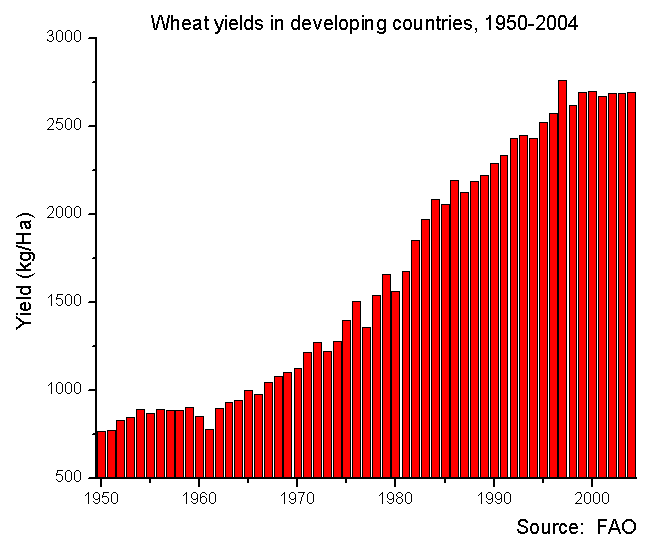Hey, everyone! This is Yann, one of
the team members. I’m really interested in talking about GMOs, so I wrote about
them today.
For
millenniums, farming was simple; soil was tilled, seeds were planted, and crops
were irrigated before being harvested. No great global initiative was taken to avoid
great agricultural crises, for there weren’t very many, until the Great Bengal
Famine of 1943. Around 4000 square miles of agricultural land was damaged and
reserve stocks were destroyed. It is estimated that between 1.5 and 4 million out
of 60.3 people died of starvation, malnutrition and disease.
 |
| Devastated children in the Great Bengal Famine |
A
calamity of this level got scientists and politicians thinking. What if there
was a way to make crops more resistant to catastrophes? How could we improve
the yield of crops? Some agronomists developed cereal grain varieties that were
semi-dwarf, high-yield, and disease-resistant. In 1961, this system was
implemented region of Punjab (situated in Northern India). Instantaneous
success in the program brought forward new clients like Mexico, Pakistan, and
the Philippines. Soon enough, the “Green Revolution” was in full swing.
The
successes of the Green Revolution were remarkable. By 1970, India and
Pakistan’s wheat production had nearly doubled. Wheat efficiency got remarkably
better; in 1964, India produced 12 million tons of wheat on 14 million hectares
of land. 30 years later, that number had risen to 57 million tons on only 24
million hectares of land. Many countries that underwent a green revolution
became self-sustainable and economies were boosted. The Green Revolution is
credited to have saved the lives of up to a billion people, with figures like
hunger and malnutrition dropping significantly thanks to its success.
 |
| A graph showing the successes of the Green Revolution |
Although the Green Revolution was
very successful in many regards, many issues have immerged that once again
challenge global agriculture. Corporations like Monsanto have now taken control
of the seed market/production, forcing farmers to continually buy new seeds
annually in order to continue farming. The problem is that it is extremely
expensive for the farmers, with 100
grams of genetically modified seed costing £10, compared with less than £10 for
1,000 times more traditional seeds. In addition to the cost of the seeds,
farmers need to purchase stronger pumps in order to irrigate their high-yield
crops (which need quite a lot more water than normal crops). In order to pay
these debts, many farmers are forced to get loans from high-interest unofficial
lenders that charge as much as 24% interest.
 |
| A crop duster spreading harmful pesticides |
There
are also environmental impacts due to genetically modified crops, for instance,
the high amount of chemical fertilizers has led to 6% of all agricultural land
being rendered anemic. Also, due to the increased amount of irrigation needed
to sustain the high-yield crops, the aquifers of northern India fell by about
four inches per year from 2002 through 2008 - representing about the same total
volume of water as melted from Alaska's glaciers over the same period.
Genetically modified farming has progressively become a less sustainable
practice; a great ecological issue that will have to be dealt with in the
future.
Genetically
modified crops have radically changed the global landscape in numerous ways,
from how we get our food to how much we get. Although the Green Revolution has
been key to our growth as a planet, it raises many issues for the next
generations to come. Whether we continue to follow this path of genetically
modified foods or redirect our focus to other systems, the Green Revolution has
made us realize that there’s more to food and agriculture than we think.
I hope
you liked my first article! Please support Teens Can Cook, Too by following us
on all of our social media handles below.
Stay healthy!
- Yann
No comments:
Post a Comment